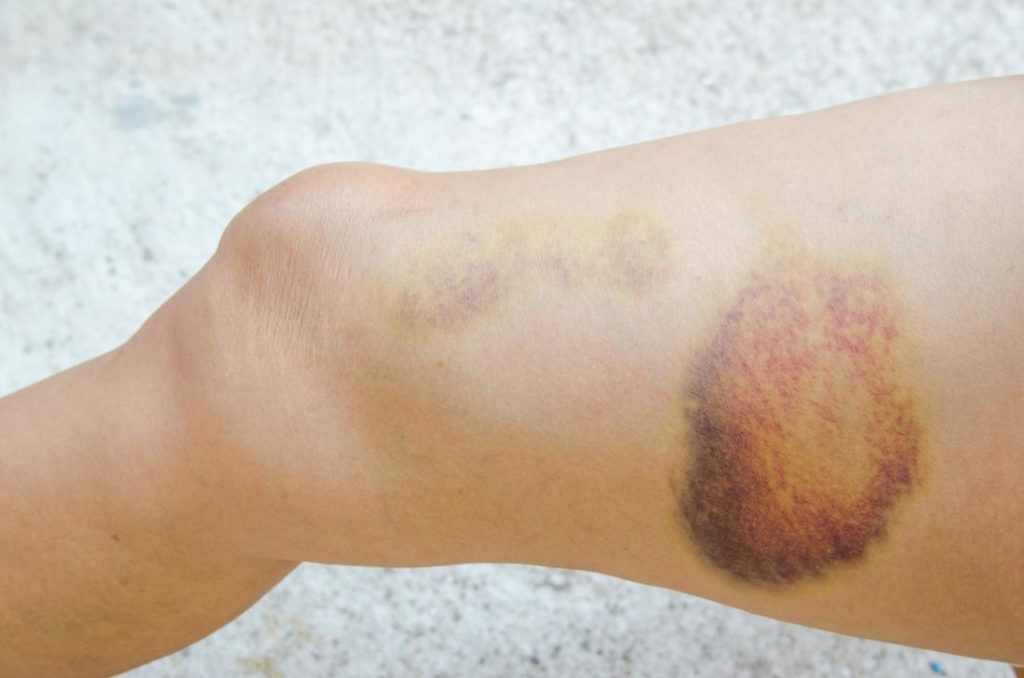HEMATOMA

Definition: A hematoma is a collection of blood, usually clotted, outside the blood vessels. [1]
Hematomas can occur almost anywhere on the body. In minor injuries, the blood is absorbed unless infection develops. Contusions (bruises) and black eyes are familiar forms of hematoma.
Less serious types include subungual hematoma (under a fingernail or toenail); hematoma auris (in the tissues of the outer ear, better known as cauliflower ear); and perianal hematoma (under the skin around the anus).
They are especially serious when they occur inside the skull, where they may place local pressure on the brain, notably epidural and subdural hematomas. [2]
Causes of a Hematoma
Hematomas are almost always present with a fracture and usually occur due to trauma. When people think of trauma, they generally think of car accidents, falls, head injuries, broken bones, and gunshot wounds, etc… Trauma to tissue may also be caused by an aggressive sneeze or an unexpected twist of a limb. When a blood vessel is damaged blood leaks into the surrounding tissue; this blood tends to coagulate or clot. The greater the amount of bleeding that occurs, the larger the amount of clot formation.
Blood vessels that are fragile may contribute to hematoma formation. For example, an aneurysm or weakening in a blood vessel wall may spontaneously leak.
There are many people who take blood thinners (anti-coagulation) medications. Examples include warfarin (Coumadin), aspirin, clopidogrel (Plavix) and prasugrel (Effient). These medications increase the potential for spontaneous bleeding and for hematomas to expand because the body cannot efficiently repair blood vessels and blood continues to leak through the damaged areas.
Occasionally, diseases may occur that decrease the number of platelets in the blood stream (thrombocytopenia) or their ability to function. The platelets are the cells that help initiate blood clot and fibrin formation. [3]
Symptoms
Blood that escapes from the blood stream is very irritating and may cause symptoms of inflammation including pain, swelling and redness. Symptoms of a hematoma depend upon their location, their size and whether they cause associated swelling or edema. [2]
In general, superficial hematomas of skin, soft tissue, and muscle tend to resolve over time. The initial firm texture of the blood clot gradually becomes more spongy and soft as the clot is broken down by the body and the shape changes as the fluid drains away and the hematoma flattens. The color changes from that of a purplish-blue bruise to yellows and browns as the blood chemicals gradually are removed and the hematoma resolves. Depending upon its location, the discolorations may travel through different tissue planes by gravity. For example, a forehead hematoma may cause bruising beneath the eyes and seem to travel to the neck as it resolves over time. [3]
Symptoms of critical hematomas involving the brain include but are not limited to: visual changes, slurred speech, numbness or tingling, vomiting, confusion, loss of consciousness, and headache.
Treatment of Hematoma
Hematomas are often described based upon their location.
Hematomas involving the Brain
Hematomas that occur intracranially require immediate specialized medical attention. Types of hematomas that are very dangerous and can cause brain injury or death include:
Epidural hematomas occur when bleeding accumulates in the epidural space, outside the ‘dura’ which is the lining of the brain.
Subdural hematomas occur because of trauma, usually to the veins in the brain. This causes a slower leak of blood, which enters the ‘subdural’ space below the dura. The space below the dura has much more room for blood to accumulate before brain function suffers. Bleeding into the subdural space may be very slow, gradually stop, and not cause acute symptoms. These ‘chronic’ subdural hematomas are often found incidentally on computerized tomography (CT) scans as part of a patient evaluation for confusion or because another traumatic incident occurred.
Intracerebral hematomas occur within the brain tissue itself. Intracerebral (intra= within + cerebrum=brain) hematomas may be due to bleeding from uncontrolled high blood pressure, an aneurysm leak or rupture, trauma, tumor or stroke.
Intracranial, epidural, subdural, and intracerebral hematomas often need neurosurgical intervention to stabilize the injury. [3]
Treatment for other Hematomas
For contusions (bruises), which are what most other hematomas manifest themselves as, treatment consists of initially applying ice or cold packs a few times a day. This produces vasoconstriction (a reduction in arterial blood flow) which helps to decrease hemorrhage (bleeding) and edema (swelling). In general, the quicker you apply ice after the injury, the less bleeding will result.
If possible, elevate the bruised limb. Blood will leave the area of the wound and there may be less swelling. Resting the limb will also help to prevent further injury.
If the area is still painful after about 48 hours, apply gentle heat with warm towels, a hot water bottle, or a heating pad. The heat is applied for 20 minutes at a time to promote absorption and repair. Since heat causes swelling and increases tissue fluid, which may impair function, hot compresses may be followed by cold applications to minimize the secondary effects of heat.
Pressure in the form of an elastic adhesive bandage may be helpful to reduce hemorrhage and swelling. If infection should develop in the wound, the signs and symptoms might be increasingly severe pain, a fever of 101 degrees or more, swelling with surrounding redness, and pus. If any of these signs appear, your physician should be notified to make sure there are no additional problems. [2]
These steps for the care of a hematoma are summarized by the acronym RICE.
R – Rest
I – Ice
C – Compression
E – Elevation
Possible Complications
Hematomas cause swelling and inflammation. It is often these two consequences that cause irritation of adjacent organs and tissues and cause the symptoms and complications of a hematoma.
One common complication of all hematomas is the risk of infection. While the hematoma is made of old blood, it has no blood supply itself and therefore is at risk for colonization with bacteria. [3]


